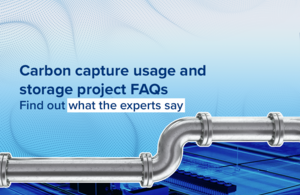CCUS explained: experts answer your questions
Got a question about Carbon Capture, Usage, and Storage (CCUS) and the technology involved? Experts answer some of the most common questions here.

How does CCUS work?
Olivia Powis, CEO at the Carbon Capture and Storage Association, says:
Carbon Capture, Usage, and Storage (CCUS) is essential for reducing emissions from heavy industries. It can also be used to generate low-carbon power by gas power stations with carbon capture and storage as well as enabling hydrogen power. These sources of power are important for when the sun isn’t shining, and the wind isn’t blowing.
This low carbon technology captures carbon dioxide (CO2) emissions from industrial facilities, compresses it, and then transports it by pipeline or ship for utilisation or safe and permanent storage deep under the seabed, preventing the CO2 from entering the atmosphere. The CO2 is stored in porous rocks - in old oil fields, gas fields, or saline formation - that act like a sponge and are covered by layers of trapping mechanisms such as impermeable ‘caprock’ - ensuring safe and permanent storage. The CO2 is then monitored to make sure that its stored securely.
Is CCUS a proven technology?
Professor Stuart Haszeldine, Professor of Carbon Capture and Storage at University of Edinburgh, says:
Yes, carbon capture and storage has been operating successfully and safely since 1996 at the Sleipner storage site in the North Sea, halfway between Aberdeen and Bergen. A similar project has been developed at Snøhvit offshore in Norway. Experience gained in those operations has led to the Northern Lights project, situated north of Bergen which offers secure CO2 storage commercially to European industries.
Is CCUS safe?
Professor Niall Mac Dowell, Professor in Energy Systems Engineering at Imperial College London, says:
Yes, various technical components of the carbon capture, utilisation, transport, and storage value chain have all been extensively deployed in other contexts around the world for decades. In the UK, not only can existing Health and Safety legislation effectively regulate the safety of CCUS, but we are also fortunate to have a wealth of experience in the offshore industry, which will be used to safely store the CO2 several kilometres below the seabed, in formations similar to those that have trapped natural gas for millennia.
Does CCUS help us tackle climate change?
Chris Stark, former CEO at the Climate Change Committee and Head of Mission Control for Clean Power 2030 at the Department of Energy Security & Net Zero, says:
CCUS provides the lowest cost pathway to reaching net zero which is why the independent Climate Change Committee has declared it a ‘necessity, not an option.’ CCUS gives a range of options to decarbonise that would otherwise not be possible, and it minimises the climate warming emissions released to the atmosphere on our journey to net zero. It will be an important part of our industrial future.
With an increase in renewable energy, why do we need CCUS?
Louise Stott, Deputy Director for Policy at Energy UK, says:
To help secure our energy supply, we need low-carbon power that is available at all times of the day and in all weathers. Gas-fired power stations with CCUS, used alongside all other forms of low-carbon energy generation, will be able to provide flexible power on the system. Beyond power generation, CCUS will also play an important role in the decarbonisation of heavy industry. There are certain industrial processes, such as cement production, which will only be able to decarbonise through technologies like carbon capture.
Is CCUS too expensive?
Mathilde Fajardy, Energy Analyst at the International Energy Agency, says:
CCUS technologies are critical to put energy systems around the world on a sustainable path. The cost of a project depends heavily on the source of the CO2 captured, the distance and mode used to transport it, as well as where and how it is stored. The cost of CCUS also needs to be considered against alternative decarbonisation options – in some cases, CCUS may be the only option available today.
Is there enough space to safely store carbon captured by CCUS projects?
Stuart Payne, CEO at the North Sea Transition Authority, says:
The North Sea has the potential to store up to 78 GT of CO2 in a combination of depleted oil and gas reservoirs and natural saline aquifers. That could be enough capacity on the UK Continental Shelf to store centuries worth of UK emissions. In fact, we believe we have an exceptional case for the UK to become a carbon storage centre for the world.
Further information
Read more about UK carbon capture, usage and storage.